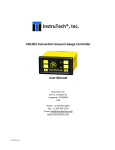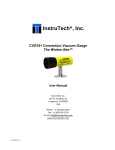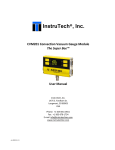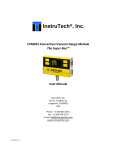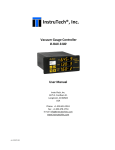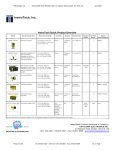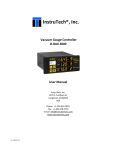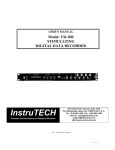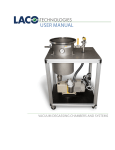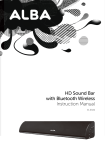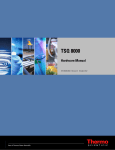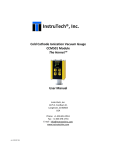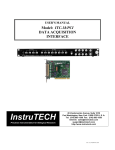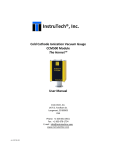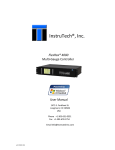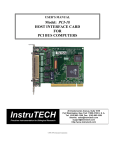Download InstruTech®, Inc.
Transcript
InstruTech®, Inc. VGC301 Convection Vacuum Gauge Controller User Manual InstruTech, Inc. 1475 S. Fordham St. Longmont, CO 80503 USA Phone: +1-303-651-0551 Fax: +1-303-678-1754 E-mail [email protected] www.instrutechinc.com p/n 000363-108 Copyright © 2012 by InstruTech, Inc. All rights reserved. No part of this work may be reproduced or transmitted in any form or by any means, electronic or mechanical, including photocopying and recording, or by any information storage or retrieval system, except as may be expressly permitted in writing by InstruTech, Inc. Printed in the United States of America Convectron® and Granville-Phillips® are registered trademarks of Brooks Automation, Inc. Chelmsford, MA p/n 000363-108 Instruction Manual VGC301A Controller Table of Contents 1 2 3 Introduction / General Information ......................................................................................................3 1.1 Description ....................................................................................................................................3 1.2 Specifications ................................................................................................................................3 1.3 Dimensions ....................................................................................................................................4 1.4 Part Numbers ................................................................................................................................4 Important Safety Information ...............................................................................................................6 2.1 Safety Precautions - General.........................................................................................................6 2.2 Safety Precautions - Service and operation ..................................................................................7 2.3 Electrical Conditions......................................................................................................................7 2.3.1 Proper Equipment Grounding ...............................................................................................7 2.3.2 Electrical Interface and Control .............................................................................................8 2.4 Overpressure and use with hazardous gases ...............................................................................8 2.5 Gases other than Nitrogen / air ....................................................................................................8 Installation ............................................................................................................................................9 3.1 Mechanical Installation .................................................................................................................9 3.2 4 Electrical Installation ...................................................................................................................10 3.2.1 Grounding ............................................................................................................................10 3.2.2 Electrical Connections..........................................................................................................10 Setup and Operation ...........................................................................................................................12 4.1 User Interface Basics ...................................................................................................................12 4.2 Programming...............................................................................................................................12 4.3 Return to Factory Default Settings .............................................................................................14 5 Using the gauge with different gases .................................................................................................15 6 Display .................................................................................................................................................17 6.1 Display - Torr / mTorr ..................................................................................................................17 6.2 Display - mbar .............................................................................................................................18 InstruTech, Inc. Page 1 Instruction Manual 7 8 Analog Output .....................................................................................................................................19 7.1 Non-Linear Analog Output - Torr / mTorr...................................................................................20 7.2 Non-Linear Analog Output - mbar ..............................................................................................21 7.3 Log-Linear Analog Output - Torr .................................................................................................22 7.4 Log-Linear Analog Output - mbar ...............................................................................................24 RS485 / RS232 serial communications ................................................................................................26 8.1 Device Specific Serial Communication Info.................................................................................26 8.2 9 VGC301A Controller RS485 / RS232 Command Protocol Summary ............................................................................27 Service .................................................................................................................................................28 9.1 Calibration ...................................................................................................................................28 9.2 Maintenance ...............................................................................................................................28 9.3 Troubleshooting ..........................................................................................................................28 10 Factory Service and Support ...........................................................................................................29 11 Warranty .........................................................................................................................................29 InstruTech, Inc. Page 2 Instruction Manual VGC301A Controller 1 Introduction / General Information 1.1 Description The VGC301 vacuum gauge controller is a convenient and inexpensive power supply and readout instrument for the InstruTech® CVG101 Worker Bee™ convection-enhanced Pirani vacuum gauge sensor or a Granville-Phillips® 275 Convectron®. The 1/8-DIN housing can be used as a bench top, or mounted in a cutout in an instrument panel. The VGC301 is powered by user supplied 12 to 30 Vdc, 2 W, or by the InstruTech series PS301 optional power supplies. Thermal conductivity gauges measure pressure indirectly by sensing the loss of heat from a sensor to the surrounding gases. The higher the pressure of the surrounding gas, the more heat is conducted away from the sensor. Pirani thermal conductivity gauges maintain a sensor (usually a wire) at some constant temperature, and measure the current or power required to maintain that temperature. A standard Pirani gauge has a useful measuring range of about 10-4 Torr to 10 Torr. By taking advantage of convection currents that are generated above 1 Torr, convection-enhanced Pirani gauges increase the measuring range to just above atmosphere. The VGC301 signals and relay functions are the same as found on similar convection gauge controllers from other manufacturers. The VGC301 Controller, CVG101 vacuum gauge tube and gauge cable can be directly interchanged with Brooks Automation, Inc. / Granville-Phillips® 375 controller, 275 Convectron® gauge and gauge cable (Remote interface, relay and power connectors are different). 1.2 Specifications measurement range (signal) display display engineering units display update rate weight temperature humidity altitude analog output (user-selectable) serial communications housing input power setpoint relays connectors RF/EMI protection environmental InstruTech, Inc. -4 -4 -2 1.0 x 10 to 1000 Torr / 1.3 x 10 to 1333 mbar / 1.3 x 10 Pa to 133 kPa Bright OLED, 4 digits, user-selectable Torr, mbar, or Pa, (4 digits from 1100 Torr to 1000 Torr), (3 digits from 999 Torr to 10.0 mTorr), (2 digits from 9.9 mTorr to 1.0 mTorr ), (1 digit from 0.9 mTorr to 0.1 mTorr) Torr, mbar, or Pa - user selectable 0.5 sec 9 oz. (250 g) o o operating; 0 to +40 C storage; -40 to +70 C 0 to 95% relative humidity, non-condensing operating; 6,560 ft. (2,000 m) max storage; 41,000 ft. (12,500 m) max a) log-linear 1 to 8 Vdc, 1 V/decade, or b) linear 0 to 10 Vdc c) non-linear S-curve 0.375 to 5.659 Vdc RS232 and 2 wire/4 wire RS485 - ASCII protocol 1/8-DIN panel-mount enclosure (aluminum extrusion) 12-30 Vdc, 2 W two single-pole double-throw relays (SPDT) 1 A at 30 Vdc resistive, or ac non-inductive gauge: 9-pin D-sub female (mating connector provided as part of the gauge cable) analog output and serial communications interface: 9-pin D-sub male relay outputs: 6-pin pluggable terminal block (mating connector included) power: 2-pin pluggable terminal block (mating connector included) CE compliant RoHS compliant Page 3 Instruction Manual 1.3 Dimensions 1.4 Part Numbers VGC301A Controller P/N VGC301A VGC301 Convection Vacuum Gauge Controller Optional PS301 Power Supply for VGC301 controller with North American AC Plug PS301-A with Universal European AC Plug PS301-EU with UK AC Plug PS301-UK with China AC Plug P301-C with Australian AC Plug PS301-SP This variation of the PS301 power supply may be used when an AC plug that is not listed above is required. The conventional IEC60320 AC power entry receptacle allows use with any user supplied AC mains power cord set available worldwide. InstruTech, Inc. PS301-UX Page 4 Instruction Manual VGC301A Controller Part Numbers continued Vacuum Gauge Cable For connecting the CVG101 Worker Bee™ vacuum gauge sensor to the VGC301 controller InstruTech CVG101 Worker Bee Convection Vacuum Gauge Sensor P/N 10 ft. (3 m): 25 ft. (8 m): 50 ft. (15 m): over 50 ft. or custom lengths: CB421-1-10F CB421-1-25F CB421-1-50F Consult Factory Combination 1/8 in. NPT male - 1/2 in. tube (use 1/8" NPT male or 1/2" O.D. O-ring compression) CVG101GA NW16KF NW25KF NW40KF 1 1/3 in. Mini-CF / NW16CF Mini-Conflat® 2 3/4 in. CF / NW35CF Conflat® 1/4 in. Cajon® 4VCR® female 1/2 in. Cajon® 8VCR® female InstruTech, Inc. CVG101GB CVG101GC CVG101GD CVG101GE CVG101GF CVG101GG CVG101GH Page 5 Instruction Manual 2 VGC301A Controller Important Safety Information InstruTech has designed and tested this product to provide safe and reliable service, provided it is installed and operated within the strict safety guidelines provided in this manual. Please read and follow all warnings and instructions. WARNING WARNING To avoid serious injury or death, follow the safety information in this document. Failure to comply with these WARNING safety procedures could result in serious bodily harm, including death, and or property damage. Failure to comply with these warnings violates the safety standards of installation and intended use of this instrument. InstruTech, Inc. disclaims all liability for the customer’s failure to comply with these instructions. Although every attempt has been made to consider most possible installations, InstruTech cannot anticipate every contingency that arises from various installations, operation, or maintenance of the controller. If you have any questions about the safe installation and use of this product, please contact InstruTech. 2.1 Safety Precautions - General Hazardous voltages are present with this product during normal operation. The product should never be operated with the enclosure removed unless equivalent protection of the operator from accidental contact with hazardous internal voltages is provided. WARNING! There are no operator serviceable parts or adjustments inside the product enclosure. Refer servicing to service trained personnel. Do not modify this product or substitute any parts without authorization of qualified InstruTech service trained personnel. Return the product to an InstruTech qualified service and repair center to ensure that all safety features are maintained. Do not use this product if unauthorized modifications have been made. WARNING! Source power must be removed from the product prior to performing any servicing. After servicing this product, ensure that all safety checks are made by a qualified service person. When replacement parts are required, ensure that the parts are specified by InstruTech, Inc. Substitutions of nonqualified parts may result in fire, electric shock or other hazards. Use of unauthorized parts or modifications made to this product will void the warranty. To reduce the risk of fire or electric shock, do not expose this product to rain or moisture. These products are not waterproof and careful attention must be paid to not spill any type of liquid onto these products. Do not use these products if they have been damaged. Immediately contact InstruTech, Inc. to arrange return of the product if it is damaged. InstruTech, Inc. Page 6 Instruction Manual VGC301A Controller Due to the possibility of corrosion when used in certain environmental conditions, it is possible that the product’s safety could be compromised over time. It is important that the product be periodically inspected for sound electrical connections and equipment grounding. Do not use if the equipment grounding or electrical insulation has been compromised. 2.2 Safety Precautions - Service and operation Ensure the enclosure of the VGC301 is connected directly to a good quality earth ground. Ensure that the vacuum port on which the CVG101 vacuum gauge tube is mounted is electrically grounded. Use an appropriate power source of 12 to 30 Vdc, 2 W or use InstruTech series PS301 optional power supplies. Turn off power to the unit before attempting to service the controller. Turn off power to the unit if a cable or plug is damaged or the product is not operating normally according to this instruction manual. Contact qualified InstruTech service personnel for any service or troubleshooting condition that may not be covered by this instruction manual. It is important that the product be periodically inspected for sound electrical connections and equipment grounding. Do not use if the equipment grounding or electrical insulation has been compromised. Do not use if the unit has been dropped or the enclosure has been damaged. Contact InstruTech for return authorization and instructions for returning the product to InstruTech for evaluation. 2.3 Electrical Conditions WARNING! When high voltage is present in any vacuum system, a life threatening electrical shock hazard may exist unless all exposed electrical conductors are maintained at earth ground potential. This applies to all products that come in contact with the gas contained in vacuum chambers. An electrical discharge within a gaseous environment may couple dangerous high voltage directly to any ungrounded conductor of electricity. A person could be seriously injured or killed by coming in contact with an exposed, ungrounded electrical conductor at high voltage potential. This condition applies to all products that may come in contact with the gas inside the vacuum chamber (vacuum/pressure containment vessel). 2.3.1 Proper Equipment Grounding WARNING! Hazardous voltages that could seriously injure or cause death are present in many vacuum processes. Verify that the vacuum port on which the CVG101 vacuum gauge tube is mounted is electrically grounded. Consult a qualified Electrician if you are in doubt about your equipment grounding. Proper grounding of your equipment is essential for safety as well as intended operation of the equipment. The CVG101 vacuum gauge tube and enclosure of the VGC301 controller must be connected directly to a good quality earth ground. Use a ground lug on the CVG101 gauge vacuum connection / flange if necessary. InstruTech, Inc. Page 7 Instruction Manual VGC301A Controller WARNING! In order to protect personnel from electric shock and bodily harm, shield all conductors which are subject to potential high voltage electrical discharges in or around the vacuum system. 2.3.2 Electrical Interface and Control It is the user’s responsibility to ensure that the electrical signals from this product and any connections made to external devices, for example, relays and solenoids, are used in a safe manner. Always double check the system set-up before using any signals to automate your process. Perform a hazardous operation analysis of your system design and ensure safeguards and personnel safety measures are taken to prevent injury and property damage. 2.4 Overpressure and use with hazardous gases WARNING! Install suitable protective devices that will limit the level of pressure inside your vacuum chamber to less than what the vacuum chamber system components are capable of withstanding. InstruTech gauges should not be used at pressures exceeding 1000 Torr absolute pressure. In cases where an equipment failure could cause a hazardous condition, always implement fail-safe system operation. For example, use a pressure relief device in an automatic backfill operation where a malfunction could result in high internal pressures if the pressure relief device was not installed on the chamber. The CVG101 vacuum gauge tube connected to the VGC301A controller is not intended for use at pressures above 20 psia (1000 torr); DO NOT exceed 35 psig (< 2 ½ bars) pressure inside the sensor. If your chamber goes to higher pressures, you should install an isolation valve or pressure relief device to protect the gauge tube from overpressure conditions. With some fittings, actual safe overpressure conditions may be lower; for example, a quick-connect, O-ring compression fitting may forcibly release the gauge tube from the vacuum chamber fitting with only a few psi over local uncorrected barometric (atmospheric) pressure. CAUTION! If the internal pressure of a vacuum gauge device is allowed to increase above local uncorrected barometric pressure (atmospheric pressure side), vacuum fittings may release and possible overpressure conditions may cause leaks that would allow the gas inside the gauge tube to release into the atmosphere of the surrounding environment. Toxic, pyrophoric and flammable gases are examples of hazardous gases that if allowed to leak out of the vacuum/pressure containment vessel into the atmospheric environment, could cause bodily injury and possible damage to equipment. Never expose the gauge tube internal volume to pressure above local atmospheric pressure when using hazardous gases. 2.5 Gases other than Nitrogen / air WARNING! Do not attempt to use with gases other than nitrogen (N2) or air without referring to correction factor data tables. InstruTech gauges and modules are calibrated for direct readout of nitrogen or air. Do not attempt to use with other gases such as argon (Ar) or carbon dioxide (CO2) unless accurate conversion data for N2 to other gas is properly used. Refer to sections titled “Using the gauge with different gases”, “Display” and “Analog Output” for a more complete discussion. InstruTech, Inc. Page 8 Instruction Manual VGC301A Controller WARNING! Do not use the convection gauge connected to this device in an explosive atmosphere or in the presence of flammable gases, vapors or fumes. Do not use this device to measure the pressure of explosive or combustible gases or gas mixtures. The sensor wire in the gauge normally operates at 125 oC, but if malfunction should occur, the wire temperature could exceed the ignition temperature of certain combustible gases and gas mixture. This could cause an explosion which could result in serious injury or death. 3 3.1 Installation Mechanical Installation The VGC301 is designed for use on a bench top, or it may be mounted in an instrument control panel. To mount the VGC301 in a panel: 1. Make a cutout in your instrument control panel as shown in the drawing above. Be sure to allow clearance behind the panel for the instrument as well as connectors and cables at the rear of the instrument 2. Gently pry the front panel bezel loose and remove. 3. Slide the VGC301 into the panel hole cutout. 4. On either side of the VGC301 are two screw-mounting brackets. When the screws in the front of the instrument are turned counterclockwise, the hold-down brackets recess out of the way into the VGC301 housing. When these screws are turned clockwise, the brackets rotate out 90o behind the panel. Tighten these screws until the brackets hold the VGC301 in place against the panel. 5. Press the front panel bezel back in place. InstruTech, Inc. Page 9 Instruction Manual 3.2 VGC301A Controller Electrical Installation 3.2.1 Grounding Be sure the vacuum gauge and your vacuum system are properly grounded to protect personnel from shock and injury. Be aware that some vacuum fittings, especially those with O-rings, may not produce a good electrical connection between the gauge and the chamber it is connected to. 3.2.2 Electrical Connections A good recommended practice is to remove power from any cable prior to connecting or disconnecting it. The InstruTech VGC301 may replace similar controllers from other manufacturers, such as the Granville-Phillips® 375 controller. Many of these other controllers employ the same 9-pin and 15-pin D connectors, but they do not all use the same signal / pinout configurations. If you wish to use your existing cables, be sure to check compatibility with the tables on the next page. Rewire your cables as necessary. Remote I/O & interface connector gauge connector relay connector DC Power Input DC Power Input The VGC301 accepts DC power from 12 to 30 Vdc, 2 W. If the user prefers to use AC power, InstruTech offers the series PS301 optional power supplies with various AC Plugs. 2-pin pluggable terminal strip (Mating connector: Phoenix p/n 1803578 or InstruTech p/n 000327). pin number pin description 1 +12 to +30 V 2 ground InstruTech, Inc. Page 10 Instruction Manual VGC301A Controller Remote I/O & Interface Connector 9-pin D-sub female (Mating connector: InstruTech p/n 000263 + 000264) pin number pin description – 4 Wire RS485 pin description – 2 Wire RS485 1 RS485 RDA (- ) Input RS485 DATA A (-) Input/output 2 RS485 RDB (+) Input RS485 DATA B (+) Input/output 3 RS485 TDA (- ) Output 4 RS485 TDB (+) Output 5 RS232 TX RS232 TX 6 RS232 RX RS232 RX 7 analog signal output analog signal output (non-linear, linear, or log-linear) (non-linear, linear, or log-linear) 8 signal ground signal ground (1) 9 relay disable relay disable(1) 1. The relays are disabled by applying a continuous ground to pin # 9. This will prevent any switching of the relay contactors during operation of the VGC301. Relay Connector 6-pin pluggable terminal strip (Mating connector: Phoenix p/n1803617 or InstruTech p/n 000347) pin number pin description 1 relay 1 common 2 relay 1 NC 3 relay 1 NO 4 relay 2 common 5 relay 2 NC 6 relay 2 NO Gauge cable assembly P/N CB421-1-XXXF is a custom cable assembly provided in different lengths from InstruTech for connecting the VGC301 controller to InstruTech CVG101 Worker Bee or Brooks Automation, Inc. / Granville-Phillips® 275 Convectron® vacuum gauge sensor. The cable pin to pin connection is shown below. VGC301 pin number 1 2 3 4 5 6 7 8 9 InstruTech, Inc. connects to CVG101 gauge pin number CVG101 molded plastic connector P/N CK431-01 NC cable shield 3 NC 2 5 1 1 NC Page 11 Instruction Manual 4 VGC301A Controller Setup and Operation User Interface Basics 4.1 The user interface is designed for easy operation and a natural progression of setup parameters. This section gives a brief explanation of operation for added clarity. Programming soft-keys There are four soft-keys located on the front panel, two on each side of the display. These keys are used to select and program the various functions available. During programming of the VGC301, the display will identify what function each key represents. To begin programming, press any one of the four keys. The display will indicate a choice of functions. Press the key indicated by the function on the display to continue with the programming of the parameter desired. After setting the various parameters, press the SAVE/EXIT key to save the new setting and return to the main screen. To continue setting additional parameters, scroll forward with the MORE key until you reach the desired parameter. Programming 4.2 SET VAC NOTICE When operating in units of either mbars (mbar) or pascals (Pa), you must perform SET ATM before setting the vacuum reading (SET VAC). See SET ATM below. Failure to do so will result in improper operation of the gauge. If you change units of measure or reset to factory defaults, then this same procedure must be followed again if the units of measure are being set to either mbar or Pa. 1. To properly set the vacuum reading (“zero” point), with the CVG101 installed on your vacuum system, the gauge should be evacuated to a pressure below 1 x 10-4 Torr. 2. Go to the SET VAC screen. When the vacuum system pressure is below 1 X 10-4 Torr, press the PRESS TO SET VAC key. The zero point (displayed pressure reading with gauge exposed to vacuum) is now set. UNITS [Factory default = TORR] This should be the first parameter that is set. This will be the units-of-measure (Torr, mbar, Pa) that are used for all other settings. If your VGC301 has been previously configured and relay setpoints and linear analog output pressure settings have been programmed, changing units-of-measure will return the relays setpoints and the linear analog output pressure settings to factory default setting values in Torr. In this case, you must reprogram the relay setpoints and linear analog output pressure settings in the newly programmed units-of-measure. InstruTech, Inc. Page 12 Instruction Manual VGC301A Controller SET ATM 1. To set the atmospheric pressure reading (also known as the “span” adjustment), flow nitrogen gas or air into your closed vacuum chamber to allow the pressure to rise to a known value above 400 Torr. Alternatively, if your local uncorrected barometric pressure (air) is known, simply vent your vacuum system chamber to expose the gauge to the local atmospheric pressure. 2. Go to the SET ATM screen. When the desired pressure is stable, adjust the displayed pressure reading on the VGC301 to the known value using the INCR (increase) or DECR (decrease) keys. Press the SAVE/EXIT key to save the new atmospheric (span) pressure value. It is good practice to perform the sequence of checking and adjusting span (ATM) then zero (VAC) and then, finally re-checking the span setting to ensure that the circuitry is properly balanced for use in measuring pressure throughout the intended measurement range. SP1 ON and SP2 ON [Factory default = 100 mTORR] These setpoints correspond to the pressures at which the relays will turn on (energize). The relays will turn on when the pressure is below the programmed pressure value. If you are unable to increase the values of SP1 ON or SP2 ON , you must first go to SP1 OFF or SP2 OFF and increase those values to a number higher than the values of SP1 ON or SP2 ON you are trying to set. SET SP1 OFF and SET SP2 OFF [Factory default = 200 mTORR] These setpoints correspond to the pressures at which the relays will turn of (de-energize). The relays will turn off when the pressure is above the programmed pressure value. If you are unable to decrease the values of SP1 OFF or SP2 OFF, you must first go to SP1 ON or SP2 ON and decrease those values to a number lower than the values of SP1 OFF or SP2 OFF you are trying to set. RS485 ADDR [Factory default = 1] This is the lower nibble of the one byte RS485 device address. Assuming the address offset (ADDR OFFSET) is equal to 0, setting the ADDR to a 5 will make the address be 0x05 in hexadecimal. A 15 will set the ADDR to 0x0F in hexadecimal. Note that the address (ADDR) must be used even when sending RS232 commands RS485 OFFSET [Factory default = 0] This is the upper nibble of the one byte RS485 address. Assuming the address (ADDR) is 0, setting the address offset (ADDR OFFSET) to a 5 will make the address be 0x50 hexadecimal. Setting the address offset to 15 will make the device address be 0xF0 hexadecimal. ADDRESS DECIMAL 1 5 15 16 InstruTech, Inc. ┌ -----------------------------BINARY ADDRESS-----------------------------┐ ┌ -------------------------------------ONE BYTE-----------------------------------┐ ADDRESS HEXADECIMAL (BINARY) ADDR OFFSET ADDR ┌Upper nibble┐ ┌Lower nibble┐ 0000 0001 01 0000 0101 05 0000 1111 0F 0001 0000 F0 Page 13 Instruction Manual VGC301A Controller BAUD [Factory default = 19,200] This sets the baud rate for the RS485 and the RS232 serial communications. The baud rate can be set to various values through the serial interface or via the front panel soft-keys. The parity can only be changed through the serial interface command set. When this occurs, the current setting will be shown in the list of choices and can be re-selected if changed. RS485 Type [Factory default = 2 WIRE] Selects 2-wire or 4-wire configuration for RS485 interface. ANALOG TYPE [Factory default = LOG] Select “NONLIN” for non-linear (S-Curve) or “LOG” for log-linear or “LINEAR” analog output (See Analog Output section). SET LINEAR [Factory default = 0.01 VOLTS to 10 VOLTS corresponding to 1 mTORR to 1 TORR] This will take the user to four different screens to setup the linear analog output (See Analog Output section). a) Set the minimum pressure b) Set the minimum voltage corresponding to the minimum pressure c) Set the maximum pressure d) Set the maximum voltage corresponding to the maximum pressure The linear output voltage can be any value between 0.01 Vdc and 10 Vdc corresponding to pressures between 1 mTorr and 1000 Torr. INFO This screen shows the unit firmware version. 4.3 Return to Factory Default Settings You can reset all values to the original factory default settings by simultaneously pressing the upper left and upper right soft-keys. The user will then be prompted to “Set Factory Defaults?” Choose Yes or No. InstruTech, Inc. Page 14 Instruction Manual 5 VGC301A Controller Using the gauge with different gases A thermal conductivity gauge senses heat loss which depends on the thermal conductivity of the gas surrounding the sensor. Since different gases, and mixtures, have different thermal conductivities, the indicated pressure readings and outputs will also be different. InstruTech convection gauges (and most other thermal conductivity gauges) are calibrated using nitrogen (N2). When a gas other than N2 / air is used, correction must be made for the difference in thermal conductivity between nitrogen (N2) and the gas in use. The charts and tables on the following pages indicate how different gases affect the display and output from an InstruTech convection gauge. WARNING! Using a thermal conductivity gauge with gases other than that for which it is calibrated could result in death or serious injury. Be sure to use gas correction data in this manual when measuring pressures of gases other than N2 / air. -4 For N2 the calibration shows excellent agreement between indicated and true pressure throughout the range from 10 to 1000 Torr. At pressures below 1 Torr, the calibration curves for the different gases are similar. The difference in readings at these low pressures is a constant, a function of the difference between thermal conductivities of the gases. At pressures above 1 Torr, indicated pressure readings may diverge significantly. At these higher pressures convection currents in the gauge become the predominant cause of heat loss from the sensor and calibration depends on gauge tube geometry and mounting position as well as gas properties. Generally, air and N2 are considered the same with respect to thermal conductivity, but even N 2 and air will exhibit slight differences in readings at higher pressures. For example, when venting a system to atmosphere using N2, you may see readings change by 30 to 40 Torr after the chamber is opened and air gradually displaces the N 2 in the gauge. For most other gases the effect is much more significant and may result in a hazardous condition as described below. Other considerations when using gases other than N2 / air Flammable or explosive gases WARNING! InstruTech convection gauges are neither intrinsically safe nor explosion proof and are not intended for use in the presence of flammable or explosive gases or vapors. Under normal conditions the voltages and currents in InstruTech convection gauges are too low to cause ignition of flammable gases. However, under certain failure conditions, sufficient energy could be generated to cause flammable vapors or gases to ignite or explode. Thermal conductivity gauges like the InstruTech convection gauges are not recommended for use with flammable or explosive gases. Moisture / water vapor In some processes (lyophilization, for example) the gas composition may not change significantly, except for moisture content. Water vapor can significantly change the response of a thermal gauge and correction should be made, as you would for any other gas. Other contaminants If your gases condense, coat, or corrode the sensor, the gauge calibration and response to different gases will change. Generally, if the gauge can be "calibrated" ("zero" and "span" settings), these changes are small enough to be ignored. If you can’t set zero and span, the gauge should be replaced or return to factory for evaluation and possible cleaning. InstruTech, Inc. Page 15 Instruction Manual VGC301A Controller Convection Vacuum Gauge Indicated vs. True Total Pressure Test Gases - N2, Ar, He 1000 Ar 100 True Total Pressure (Torr) (capacitance manometer) N2 10 He 1 0.1 0.01 0.001 0.0001 0.0001 0.001 0.01 0.1 1 10 100 1000 Indicated Pressure (Torr) (convection gauge) CVG N2 Convectron N2 CVG Ar Convectron Ar Convectron He CVG He Gas Correction Chart The Y- axis of the above chart is actual pressure as measured by a capacitance manometer, a diaphragm gauge that measures true total pressure independent of gas composition. The X-axis is the pressure reading indicated by the convection gauge under test. This chart shows readings for an InstruTech convection gauge (CVG) and Granville-Phillips® Convectron® gauge to illustrate that the difference in the response for both of these types of gauges is virtually indistinguishable. CAUTION! Do not assume this data applies to other convection gauges which may or may not be the same. Refer to the table on the next page and note the following examples: Ex A: If the gas is nitrogen (N2), when the true total pressure is 500 Torr, the gauge will read 500 Torr. Ex B: If the gas is argon (Ar), when the true pressure is 100 Torr, the gauge will read about 9 Torr. If you are backfilling your vacuum system with Ar, when your system reaches a pressure of 760 Torr true pressure your gauge will be reading about 23 Torr. Continuing to backfill your system, attempting to increase the reading up to 760 Torr, you will over pressurize your chamber which may present a hazard. Ex C: If the gas is helium (He), the gauge will read 999 Torr when pressure reaches about 10 Torr true pressure and opening the chamber to atmosphere prematurely may present other hazards for both people and product. CAUTION! What these examples illustrate is that using gases other than nitrogen (N2) without using accurate gas conversion data and other proper precautions could result in injury to personnel and/or damage to equipment. Suggested precautions when using gases other than nitrogen (N2): Install a pressure relief valve or burst disk on your chamber, to protect it from overpressure. Post a warning label on your gauge readout that states "Do Not Exceed ____ Torr Indicated Pressure" (fill in the blank for maximum indicated pressure for the gas you use) so that an operator using the gauge will not exceed a safe pressure. InstruTech, Inc. Page 16 Instruction Manual VGC301A Controller 6 Display 6.1 Display - Torr / mTorr The table below shows the displayed readings at various pressures for selected gases when engineering units selected is in Torr/mTorr. Displayed Pressure Readings vs. True Pressure for selected gases Pressures shown in bold italic font in the shaded areas are in mTorr. Pressures shown in normal font and in non-shaded areas are in Torr. True Total Pressure 0 0.1 0.2 0.5 1 2 5 10 20 50 100 200 500 1 2 5 10 20 50 100 200 300 400 500 600 700 760 800 900 1000 mTorr mTorr mTorr mTorr mTorr mTorr mTorr mTorr mTorr mTorr mTorr mTorr mTorr Torr Torr Torr Torr Torr Torr Torr Torr Torr Torr Torr Torr Torr Torr Torr Torr Torr N2 Ar He O2 CO2 Kr Freon12 Freon22 D2 Ne CH4 0.0 0.1 0.2 0.5 1.0 2.0 5.0 10.0 20.0 50.0 100 200 500 1.00 2.00 5.00 10.0 20.0 50.0 100 200 300 400 500 600 700 760 800 900 1000 0.0 0.1 0.2 0.5 0.7 1.4 3.3 6.6 13.1 32.4 64.3 126 312 600 1.14 2.45 4.00 5.80 7.85 8.83 9.79 11.3 13.5 16.1 18.8 21.8 23.7 25.1 28.5 32.5 0.0 0.1 0.2 0.5 0.8 1.6 4.0 8.1 16.1 40.5 82.0 165 435 940 2.22 13.5 OP OP OP OP OP OP OP OP OP OP OP OP OP OP 0.0 0.1 0.2 0.5 1.0 2.0 5.0 9.7 19.8 49.2 97.2 194 486 970 1.94 4.98 10.3 22.3 77.6 209 295 380 485 604 730 859 941 997 OP OP 0.0 0.1 0.2 0.5 1.1 2.3 4.4 11.0 22.2 54.9 107 210 489 950 1.71 3.34 4.97 6.59 8.22 9.25 12.3 16.9 22.4 28.7 36.4 46.1 53.9 59.4 79.5 111 0.0 0.1 0.2 0.3 0.4 1.0 2.3 4.8 9.5 23.5 46.8 91.1 217 400 700 1.28 1.78 2.29 2.57 2.74 3.32 3.59 3.94 4.21 4.44 4.65 4.75 4.84 4.99 5.08 0.0 0.1 0.2 0.5 1.5 3.1 7.6 14.7 29.9 72.5 143 275 611 1.05 1.62 2.45 2.96 3.32 3.79 4.68 5.99 6.89 7.63 8.28 8.86 9.42 9.76 9.95 10.5 11.1 0.0 0.1 0.2 0.5 1.5 3.1 7.0 13.5 27.2 69.0 136 262 594 1.04 1.66 2.62 3.39 3.72 4.14 4.91 6.42 7.52 8.42 9.21 9.95 10.7 11.1 11.4 12.0 12.7 0.0 0.1 0.2 0.5 1.3 2.4 6.0 12.1 24.3 60.0 121 250 687 1.55 4.13 246 OP OP OP OP OP OP OP OP OP OP OP OP OP OP 0.0 0.1 0.2 0.5 0.7 1.5 3.5 7.1 14.1 34.8 70.0 141 359 745 1.59 5.24 21.5 584 OP OP OP OP OP OP OP OP OP OP OP OP 0.0 0.1 0.2 0.5 1.7 3.3 7.7 15.3 30.4 77.2 159 315 781 1.60 3.33 7.53 27.9 355 842 OP OP OP OP OP OP OP OP OP OP OP Notes: 1) OP = overpressure indication: display will read over pressure 2) Display auto-ranges between Torr and mTorr at 1 Torr Examples 1) Gas used is nitrogen (N2). Display shows pressure measurement of 10 Torr. True pressure of nitrogen is 10 Torr. 2) Gas used is argon (Ar). Display shows pressure measurement of 600 mTorr. True pressure of argon is 1 Torr. 3) Gas used is oxygen (O2). Display shows pressure measurement of 486 mTorr. True pressure of oxygen is 500 mTorr. InstruTech, Inc. Page 17 Instruction Manual VGC301A Controller Display - mbar 6.2 The table below shows the displayed readings at various pressures for selected gases when engineering units selected is in mbar. Displayed Pressure Readings vs. True Pressure for selected gases - Engineering units in mbar True Pressure 0 mbar .0001 mbar .0003 mbar .0006 mbar .0013 mbar .0027 mbar .0067 mbar .0133 mbar .0260 mbar .0666 mbar 0.130 mbar 0.260 mbar 0.666 mbar 1.33 mbar 2.66 mbar 6.66 mbar 13.3 mbar 26.6 mbar 66.6 mbar 133 mbar 266 mbar 400 mbar 533 mbar 666 mbar 800 mbar 933 mbar 1011 mbar 1060 mbar 1190 mbar 1330 mbar N2 0.0 .0001 .0003 .0006 .0013 .0027 .0067 .0133 .0260 .0666 0.130 0.260 0.666 1.33 2.66 6.66 13.3 26.6 66.6 133 266 400 533 666 800 933 1011 1060 1019 1330 Ar 0.0 .0001 .0003 .0006 .0009 .0019 .0044 .0088 .0174 .0431 .0857 0.160 0.410 0.790 1.51 3.26 5.33 7.73 10.4 11.7 13.0 15.0 17.9 21.4 25.0 29.0 31.5 33.4 37.9 43.3 He 0.0 .0001 .0003 .0006 .0011 .0021 .0053 .0107 .0214 .0539 0.110 0.210 0.570 1.25 2.95 17.9 OP OP OP OP OP OP OP OP OP OP OP OP OP OP O2 0.0 .0001 .0003 .0006 .0013 .0027 .0067 .0129 .0263 .0655 0.120 0.250 0.640 1.29 2.58 6.63 13.7 29.7 103 278 393 506 646 805 973 1140 1250 1320 OP OP CO2 0.0 .0001 .0003 .0006 .0015 .0031 .0059 .0146 .0295 .0731 0.140 0.270 0.650 1.26 2.27 4.45 6.62 8.78 10.9 12.3 16.3 22.5 29.8 38.2 48.5 61.4 71.8 79.1 105 147 KR 0.0 .0001 .0003 .0004 .0005 .0013 .0031 .0064 .0126 .0313 .0623 0.120 0.280 0.530 0.930 1.70 2.37 3.05 3.42 3.65 4.42 4.78 5.25 5.61 5.91 6.19 6.33 6.45 6.65 6.77 Freon12 Freon22 0.0 .0001 .0003 .0006 .0020 .0041 .0101 .0195 .0398 .0966 0.190 0.360 0.810 1.39 2.15 3.26 3.94 4.42 5.05 6.23 7.98 9.18 10.1 11.0 11.8 12.5 13.0 13.2 13.9 14.7 0.0 .0001 .0003 .0006 .0020 .0041 .0093 .0179 .0362 .0919 0.180 0.340 0.790 1.38 2.21 3.49 4.51 4.95 5.51 6.54 8.55 10.0 11.2 12.2 13.2 14.2 14.7 15.1 16.0 16.9 D2 0.0 .0001 .0003 .0006 .0017 .0032 .0080 .0161 .0323 .0799 0.160 0.330 0.91 2.06 5.50 327 OP OP OP OP OP OP OP OP OP OP OP OP OP OP Ne 0.0 .0001 .0003 .0006 .0009 .0020 .0047 .0095 .0187 .0463 0.100 0.180 0.470 0.990 2.11 6.98 28.6 778 OP OP OP OP OP OP OP OP OP OP OP OP CH4 0.0 .0001 .0003 .0006 .0023 .0044 .0102 .0203 .0405 0.100 0.210 0.410 1.04 2.13 4.43 10.0 37.1 473 1012 OP OP OP OP OP OP OP OP OP OP OP Values listed under each gas type are in mbar. Notes: 1) OP = Overpressure indication; display will read “overpressure”. Examples: 1) Gas used is nitrogen. Display shows pressure measurement of 13.3 mbar. True pressure of nitrogen is 13.3 mbar. 2) Gas used is argon. Display shows pressure measurement of 11.7 mbar. True pressure of argon is 133 mbar. 3) Gas used is CO2. Display shows pressure measurement of .0731 mbar. True pressure of CO2 is .0666 mbar. InstruTech, Inc. Page 18 Instruction Manual 7 VGC301A Controller Analog Output The VGC301 provides either a non-linear, log-linear or a 0-10 Vdc linear analog output signal. Non-Linear Output The first Convectron® gauge controllers produced a nonlinear output signal of 0.375 to 5.659 Vdc for 0 to 1000 Torr of N2, roughly in the shape of an "S" curve, as shown at right. Granville-Phillips® adopted the same output curve for most of their Mini-Convectron® modules and controllers with non-linear output (although in recent years, some Granville-Phillips® controllers may output variations of the original S-curve). Non-Linear Analog Output 6 Output - Volts 5 4 3 2 The non-linear output from InstruTech convection gauges, modules and controllers duplicates the original Scurve of 0.375 to 5.659 Vdc for 0 to 1000 Torr. 1 Pressure - Torr 10-3 10-2 10-1 100 10+1 10+2 10+3 The tables shown in section 7.1 and 7.2 contain the lookup data for converting the non-linear output voltage into pressure values for nitrogen and various other gases. Log-Linear Output Many InstruTech modules and controllers also provide a log-linear output signal, as an alternative to the nonlinear signal described above. This output, shown at right, is a 1 Volt per decade signal that may be easier to use for data logging or control. 8 7 Log-Linear Analog Output Output - Volts 6 5 4 The table shown in section 7.3 and 7.4 contain the lookup data and provides the formulas for converting the log-linear output voltage into pressure values for nitrogen and various other gases. 3 2 Pressure - Torr 1 10-3 10-2 10-1 100 10+1 10+2 10+3 Linear 0-10 Vdc Analog Output The VGC301 also provides a linear 0-10 Vdc analog output. The linear output voltage can be any value between 10 mV and 10 V corresponding to displayed pressure between 1 mTorr and 1000 Torr. However, the useful range of the linear analog output is three decades. For example if the minimum pressure selected is 1 mTorr (1.0 x 10-3 Torr) with a corresponding minimum voltage output of 0.01 volts, then maximum pressure selected to correspond to a maximum voltage output of 10 volts should not exceed 1.0 Torr. If your application requires the analog output to cover a pressure range exceeding three decades then consider using the non-linear or the log-linear analog output. Note that an analog output of less than 0.01 volts (to near 0 volt) may indicate a damaged or faulty sensor. InstruTech, Inc. Page 19 Instruction Manual 7.1 VGC301A Controller Non-Linear Analog Output - Torr / mTorr Non-Linear analog output for selected gases - Engineering units in Torr/mTorr True Total Pressure 0 0.1 0.2 0.5 1 2 5 10 20 50 100 200 500 1 2 5 10 20 50 100 200 300 400 500 600 700 760 800 900 1000 mTorr mTorr mTorr mTorr mTorr mTorr mTorr mTorr mTorr mTorr mTorr mTorr mTorr Torr Torr Torr Torr Torr Torr Torr Torr Torr Torr Torr Torr Torr Torr Torr Torr Torr N2 0.3751 0.3759 0.3768 0.3795 0.3840 0.3927 0.4174 0.4555 0.5226 0.6819 0.8780 1.1552 1.6833 2.2168 2.8418 3.6753 4.2056 4.5766 4.8464 4.9449 5.0190 5.1111 5.2236 5.3294 5.4194 5.4949 5.5340 5.5581 5.6141 5.6593 Ar 0.3750 0.3757 0.3760 0.3780 0.3810 0.3870 0.4030 0.4290 0.4770 0.5950 0.7450 0.9620 1.3860 1.8180 2.3330 3.0280 3.4800 3.8010 4.0370 4.1220 4.1920 4.2830 4.3860 4.4770 4.5500 4.6110 4.6430 4.6630 4.7060 4.7450 He 0.3750 0.3755 0.3765 0.3790 0.3820 0.3890 0.4090 0.4410 0.4970 0.6370 0.8140 1.0680 1.5890 2.1640 2.9390 4.3870 5.7740 7.3140 O2 0.3750 0.3760 0.3770 0.3800 0.3840 0.3920 0.4170 0.4530 0.5210 0.6790 0.8680 1.1410 1.6640 2.1950 2.8140 3.6720 4.2250 4.6200 4.9160 5.0260 5.1060 5.2000 5.3150 5.4220 5.5150 5.5920 5.6330 5.6580 5.7130 5.7620 CO2 0.3750 0.3760 0.3770 0.3810 0.3850 0.3950 0.4120 0.4620 0.5360 0.7050 0.9000 1.1790 1.6680 2.1720 2.6950 3.3160 3.6700 3.9030 4.0710 4.1540 4.3360 4.5020 4.6210 4.7080 4.7750 4.8300 4.8600 4.8770 4.9190 4.9550 Kr 0.3750 0.3755 0.3768 0.3772 0.3790 0.3840 0.3950 0.4150 0.4510 0.5440 0.6680 0.8470 1.1940 1.5360 1.9210 2.4290 2.7340 2.9660 3.0750 3.1340 3.2690 3.3840 3.4660 3.5260 3.5730 3.6130 3.6320 3.6450 3.6740 3.6900 Freon12 0.3750 0.3760 0.3780 0.3820 0.3880 0.4010 0.4370 0.4880 0.5810 0.7780 1.0090 1.3150 1.8260 2.2570 2.6470 3.0290 3.2040 3.3080 3.4300 3.6180 3.8270 3.9380 4.0160 4.0760 4.1240 4.1660 4.1900 4.2030 4.2370 4.2700 Freon22 0.3750 0.3760 0.3780 0.3810 0.3880 0.4000 0.4320 0.4800 0.5660 0.7640 0.9900 1.2910 1.8050 2.2470 2.6660 3.0900 3.3300 3.4140 3.5090 3.6600 3.8830 4.0050 4.0880 4.1510 4.2030 4.2470 4.2710 4.2860 4.3210 4.3540 D2 0.3750 0.3760 0.3770 0.3810 0.3860 0.3960 0.4250 0.4700 0.5490 0.7270 0.9440 1.2650 1.9140 2.6030 3.5080 5.0590 6.3610 Ne 0.3750 0.3757 0.3763 0.3782 0.3810 0.3880 0.4050 0.4330 0.4840 0.6080 0.7680 1.0020 1.4690 1.9760 2.6310 3.7150 4.6050 5.4060 6.1590 6.4830 6.6610 6.7260 6.7670 6.8030 6.8430 6.8900 6.9200 6.9420 7.0000 7.0560 CH4 0.3750 0.3766 0.3780 0.3825 0.3896 0.4030 0.4380 0.4920 0.5840 0.7960 1.0530 1.3920 2.0140 2.6320 3.3130 4.6990 5.1720 5.5830 5.7200 5.8600 6.1030 6.3420 6.5190 6.6420 Values listed under each gas type are in volts. Note: By design, these values are identical to the outputs from Brooks Automation, Inc. / Granville-Phillips® Convectron® gauges, Mini-Convectron® modules and controllers so that equivalent units can be interchanged without affecting your process system or software. An analog output of less than 0.01 volts to near 0 volt indicates a damaged or faulty sensor. InstruTech, Inc. Page 20 Instruction Manual 7.2 VGC301A Controller Non-Linear Analog Output - mbar Non-Linear analog output for selected gases - Engineering units in mbar True Pressure N2 Ar He O2 CO2 KR Freon12 Freon22 D2 Ne CH4 0 mbar 0.3751 0.375 0.375 0.375 0.375 0.375 0.375 0.375 0.375 0.375 0.375 .0001 mbar 0.3759 0.3757 0.376 0.376 0.376 0.376 0.376 0.376 0.376 0.3757 0.3766 .0003 mbar 0.3768 0.376 0.377 0.377 0.377 0.377 0.378 0.378 0.377 0.3763 0.378 .0006 mbar 0.3795 0.378 0.379 0.38 0.381 0.377 0.382 0.381 0.381 0.3782 0.3825 .0013 mbar 0.384 0.381 0.382 0.384 0.385 0.379 0.388 0.388 0.386 0.381 0.3896 .0027 mbar 0.3927 0.387 0.389 0.392 0.395 0.384 0.401 0.4 0.396 0.388 0.403 .0067 mbar 0.4174 0.403 0.409 0.417 0.412 0.395 0.437 0.432 0.425 0.405 0.438 .0133 mbar 0.4555 0.429 0.441 0.453 0.462 0.415 0.488 0.48 0.47 0.433 0.492 .0266 mbar 0.5226 0.477 0.497 0.521 0.536 0.451 0.581 0.566 0.549 0.484 0.584 .0660 mbar 0.6819 0.595 0.637 0.679 0.705 0.544 0.778 0.764 0.727 0.608 0.796 0.13 mbar 0.878 0.745 0.814 0.868 0.9 0.668 1.009 0.99 0.944 0.768 1.053 0.26 mbar 1.1552 0.962 1.068 1.141 1.179 0.847 1.315 1.291 1.265 1.002 1.392 0.66 mbar 1.6833 1.386 1.589 1.664 1.668 1.194 1.826 1.805 1.914 1.469 2.014 1.33 mbar 2.2168 1.818 2.164 2.195 2.172 1.536 2.257 2.247 2.603 1.976 2.632 2.66 mbar 2.8418 2.333 2.939 2.814 2.695 1.921 2.647 2.666 3.508 2.631 3.313 6.66 mbar 3.6753 3.028 4.387 3.672 3.316 2.429 3.029 3.09 5.059 3.715 13.3 mbar 4.2056 3.48 5.774 4.225 3.67 2.734 3.204 3.33 6.361 4.605 4.699 26.6 mbar 4.5766 3.801 7.314 4.62 3.903 2.966 3.308 3.414 5.406 5.172 66.6 mbar 4.8464 4.037 4.916 4.071 3.075 3.43 3.509 6.159 5.583 133 mbar 4.9449 4.122 5.026 4.154 3.134 3.618 3.66 6.483 5.72 266 mbar 5.019 4.192 5.106 4.336 3.269 3.827 3.883 6.661 5.86 400 mbar 5.1111 4.283 5.2 4.502 3.384 3.938 4.005 6.726 533 mbar 5.2236 4.386 5.315 4.621 3.466 4.016 4.088 6.767 666 mbar 5.3294 4.477 5.422 4.708 3.526 4.076 4.151 6.803 800 mbar 5.4194 4.55 5.515 4.775 3.573 4.124 4.203 6.843 933 mbar 5.4949 4.611 5.592 4.83 3.613 4.166 4.247 6.89 1010 mbar 5.534 4.643 5.633 4.86 3.632 4.19 4.271 6.92 1060 mbar 5.5581 4.663 5.658 4.877 3.645 4.203 4.286 6.942 1190 mbar 5.6141 4.706 5.713 4.919 3.674 4.237 4.321 7 1330 mbar 5.6593 4.745 5.762 4.955 3.69 4.270 4.354 7.056 6.103 6.342 6.519 6.642 Values listed under each gas type are in volts. Note: By design, these values are identical to the outputs from Brooks Automation, Inc. / Granville-Phillips® Convectron® gauges, Mini-Convectron® modules and controllers so that equivalent units can be interchanged without affecting your process system or software. An analog output of less than 0.01 volts to near 0 volt indicates a damaged or faulty sensor. InstruTech, Inc. Page 21 Instruction Manual 7.3 VGC301A Controller Log-Linear Analog Output - Torr Log-Linear analog output for selected gases - Engineering units in Torr True Pressure (Torr) 0.0001 0.0002 0.0005 0.0010 0.0020 0.0050 0.0100 0.0200 0.0500 0.1000 0.2000 0.5000 1.0000 2.0000 5.0000 10.0000 20.0000 50.0000 100.0000 200.0000 300.0000 400.0000 500.0000 600.0000 700.0000 760.0000 800.0000 900.0000 1000.0000 N2 Ar He O2 1.000 1.301 1.699 2.000 2.301 2.699 3.000 3.301 3.699 4.000 4.301 4.699 5.000 5.301 5.699 6.000 6.301 6.699 7.000 7.301 7.477 7.602 7.699 7.778 7.845 7.881 7.903 7.954 8.000 1.000 1.301 1.699 1.845 2.146 2.519 2.820 3.117 3.511 3.808 4.100 4.494 4.778 5.057 5.389 5.602 5.763 5.895 5.946 5.991 6.053 6.130 6.207 6.274 6.338 6.375 6.400 6.455 6.512 1.000 1.301 1.699 1.903 2.204 2.602 2.908 3.207 3.607 3.914 4.217 4.638 4.973 5.346 6.130 8.041 8.041 8.041 8.041 8.041 8.041 8.041 8.041 8.041 8.041 8.041 8.041 8.041 8.041 1.000 1.301 1.699 2.000 2.301 2.699 2.987 3.297 3.692 3.988 4.288 4.687 4.987 5.288 5.697 6.013 6.348 6.890 7.320 7.470 7.580 7.686 7.781 7.863 7.934 7.974 7.999 8.041 8.041 CO2 1.000 1.301 1.699 2.041 2.362 2.643 3.041 3.346 3.740 4.029 4.322 4.689 4.978 5.233 5.524 5.696 5.819 5.915 5.966 6.090 6.228 6.350 6.458 6.561 6.664 6.732 6.774 6.900 7.045 Kr 1.000 1.301 1.477 1.602 2.000 2.362 2.681 2.978 3.371 3.670 3.960 4.336 4.602 4.845 5.107 5.250 5.360 5.410 5.438 5.521 5.555 5.595 5.624 5.647 5.667 5.677 5.685 5.698 5.706 Freon12 1.000 1.301 1.699 2.176 2.491 2.881 3.167 3.476 3.860 4.155 4.439 4.786 5.021 5.210 5.389 5.471 5.521 5.579 5.670 5.777 5.838 5.883 5.918 5.947 5.974 5.989 5.998 6.021 6.045 Freon22 1.000 1.301 1.699 2.176 2.491 2.845 3.130 3.435 3.839 4.134 4.418 4.774 5.017 5.220 5.418 5.530 5.571 5.617 5.691 5.808 5.876 5.925 5.964 5.998 6.029 6.045 6.057 6.079 6.104 D2 Ne 1.000 1.301 1.699 2.114 2.380 2.778 3.083 3.386 3.778 4.083 4.398 4.837 5.190 5.616 7.391 8.041 8.041 8.041 8.041 8.041 8.041 8.041 8.041 8.041 8.041 8.041 8.041 8.041 8.041 1.000 1.301 1.699 1.845 2.176 2.544 2.851 3.149 3.542 3.845 4.149 4.555 4.872 5.201 5.719 6.332 7.766 8.041 8.041 8.041 8.041 8.041 8.041 8.041 8.041 8.041 8.041 8.041 8.041 CH4 1.000 1.301 1.699 2.230 2.519 2.886 3.185 3.483 3.888 4.201 4.498 4.893 5.204 5.522 5.877 6.446 7.550 7.925 8.041 8.041 8.041 8.041 8.041 8.041 8.041 8.041 8.041 8.041 8.041 Values listed under each gas type are in volts. The log-linear output signal and pressure are related by the following formulas: P = 10(V - 5) V = log10(P) + 5 where P is the pressure in torr, and V is the output signal in volts. An analog output of less than 0.01 volts to near 0 volt indicates a damaged or faulty sensor. The chart on the following page shows the graphical results of the table and formulas given above for nitrogen. True pressure (N2) is plotted on the X-axis with a log scale. The output signal is plotted on the Y-axis on a linear scale. InstruTech, Inc. Page 22 Instruction Manual VGC301A Controller Log-Linear Analog Output Voltage vs Pressure 9 8 7 Output Signal (Volts) 6 5 4 3 2 1 0 0.0001 0.001 0.01 0.1 1 10 100 1000 Pressure (Torr) Chart of the calculated pressures using the formulas and data for the log-linear output signal for nitrogen from the previous page. InstruTech, Inc. Page 23 Instruction Manual 7.4 VGC301A Controller Log-Linear Analog Output - mbar Log-Linear analog output for selected gases - Engineering units in mbar True Pressure (mbar) N2 Ar He O2 CO2 KR Freon12 Freon22 0.0001 0.0002 0.0005 0.0010 0.0020 0.0050 0.0100 0.0200 0.0500 0.1000 0.2000 0.5000 1.0000 2.0000 5.0000 10.0000 20.0000 50.0000 100.0000 200.0000 300.0000 400.0000 500.0000 600.0000 700.0000 760.0000 800.0000 900.0000 1000.0000 1100.0000 1200.0000 1300.0000 1333.0000 1.000 1.301 1.699 2.000 2.301 2.699 3.000 3.301 3.699 4.000 4.301 4.699 5.000 5.301 5.699 6.000 6.301 6.699 7.000 7.301 7.477 7.602 7.699 7.778 7.845 7.881 7.903 7.954 8.000 8.041 8.079 8.114 8.125 1.000 1.301 1.699 1.903 2.146 2.524 2.820 3.188 3.512 3.809 4.103 4.495 4.784 5.064 5.404 5.633 5.815 5.969 6.045 6.093 6.131 6.178 6.237 6.295 6.349 6.380 6.399 6.488 6.494 6.539 6.580 6.624 6.636 1.000 1.301 1.699 1.938 2.204 2.602 2.908 3.208 3.607 3.928 4.217 4.634 4.962 5.324 6.070 8.125 8.125 8.125 8.125 8.125 8.125 8.125 8.125 8.125 8.125 8.125 8.125 8.125 8.125 8.125 8.125 8.125 8.125 1.000 1.301 1.699 2.000 2.301 2.699 2.991 3.294 3.693 3.989 4.288 4.686 4.987 5.288 5.695 6.008 6.337 6.862 7.282 7.526 7.625 7.705 7.786 7.861 7.928 7.965 7.988 8.042 8.092 8.125 8.125 8.125 8.125 1.000 1.301 1.699 2.028 2.355 2.672 3.012 3.345 3.741 4.033 4.325 4.696 4.982 5.249 5.550 5.743 5.886 6.002 6.065 6.157 6.253 6.353 6.448 6.532 6.611 6.658 6.687 6.766 6.847 6.936 7.028 7.140 7.169 1.000 1.301 1.523 1.668 1.970 2.370 2.675 2.979 3.372 3.671 3.963 4.341 4.614 4.865 5.141 5.309 5.433 5.514 5.548 5.606 5.654 5.679 5.710 5.734 5.754 5.765 5.772 5.787 5.799 5.812 5.822 5.828 5.830 1.000 1.301 1.699 2.125 2.487 2.883 3.172 3.473 3.863 4.157 4.445 4.798 5.044 5.250 5.447 5.556 5.621 5.680 5.751 5.851 5.918 5.962 5.996 6.025 6.050 6.063 6.072 6.092 6.111 6.128 6.146 6.164 6.169 1.000 1.301 1.699 2.125 2.487 2.855 3.136 3.434 3.837 4.136 4.424 4.783 5.037 5.255 5.471 5.602 5.675 5.722 5.780 5.877 5.950 6.000 6.038 6.070 6.097 6.112 6.122 6.146 6.167 6.187 6.204 6.222 6.228 D2 1.000 1.301 1.699 2.080 2.392 2.778 3.082 3.385 3.779 4.082 4.393 4.828 5.174 5.579 7.288 8.125 8.125 8.125 8.125 8.125 8.125 8.125 8.125 8.125 8.125 8.125 8.125 8.125 8.125 8.125 8.125 8.125 8.125 Ne CH4 1.000 1.301 1.699 1.903 2.166 2.551 2.849 3.150 3.543 3.844 4.148 4.553 4.867 5.192 5.696 6.252 7.608 8.125 8.125 8.125 8.125 8.125 8.125 8.125 8.125 8.125 8.125 8.125 8.125 8.125 8.125 8.125 8.125 1.000 1.301 1.699 2.167 2.523 2.893 3.186 3.484 3.886 4.197 4.500 4.893 5.201 5.517 5.877 6.374 7.409 7.930 8.125 8.125 8.125 8.125 8.125 8.125 8.125 8.125 8.125 8.125 8.125 8.125 8.125 8.125 8.125 Values listed under each gas type are in volts. The log-linear output signal and pressure are related by the following formulas: P = 10(V - 5) V = log10(P) + 5 where P is the pressure in mbar, and V is the output signal in volts. An analog output of less than 0.01 volts to near 0 volt indicates a damaged or faulty sensor. The chart on the following page shows the graphical results of the table and formulas given above for nitrogen. True pressure (N2) is plotted on the X-axis with a log scale. The output signal is plotted on the Y-axis on a linear scale. InstruTech, Inc. Page 24 Instruction Manual VGC301A Controller Chart of the calculated pressures using the formulas and data for the log-linear output signal for nitrogen from the previous page. InstruTech, Inc. Page 25 Instruction Manual 8 8.1 VGC301A Controller RS485 / RS232 serial communications Device Specific Serial Communication Info The standard VGC301 model provides RS232 / RS485 serial communications. The following information and the RS485 / RS232 command protocol summary listed on the next page should be used to set serial communications with the device. 1. Default settings are 19,200 baud rate, 8 data bits, No Parity, 1 stop bit [Factory default; 19,200, 8, N, 1]. 2. The baud rate can be set to different values through the serial interface command set or the front panel push buttons. 3. The parity can be changed only through the serial interface command set and the number of data bits will change according to the parity selected. 4. The stop bit is always 1. 5. All Responses are 13 characters long. 6. xx is the address of the device (00 thru FF). 7. <CR> is a carriage return. 8. _ is a space. 9. The ‘z’ in the set or read trip point commands is a + or -. The plus is the ‘turns on below’ point and the minus is the ‘turns off above’ point. 10. All commands sent to the controller start with a ‘#’ character, and all responses from the controller start with a ‘*’ character. 11. This protocol was designed to be 100% compatible with the Granville-Phillips® Mini-Convectron®. 12. A valid address must be used even in RS232 commands [Factory default = 1]. InstruTech, Inc. Page 26 Instruction Manual 8.2 VGC301A Controller RS485 / RS232 Command Protocol Summary COMMAND READ BRIEF DESCRIPTION Read the current pressure in Torr SET ADDR OFFSET SET SPAN Set the communications (RS485) address offset (upper nibble) (1) Set the span or atmosphere calibration point Set the zero or vacuum calibration point Set the ‘turns on below’ pressure point for relay #1 and set the ‘turns off above’ pressure point for relay #1. Set the ‘turns on below’ pressure point for relay #2 and set the ‘turns off above’ pressure point for relay #2. Read the ‘turns on below’ pressure point for relay #1 and read the ‘turns off above’ pressure point for relay #1. Read the ‘turns on below’ pressure point for relay #2 and read the ‘turns off above’ pressure point for relay #2. Read the revision number of the firmware. Force unit to return ALL settings back to the way the factory programmed them before shipment. (1) Set the communications baud rate for RS485 and RS232. (1) Set the communications to NO parity, 8 bits for the RS485 and RS232. (1) Set the communications to ODD parity, 7 bits for the RS485 and RS232. (1) Set the communications to EVEN parity, 7 bits for the RS485/ RS232. (1) Reset the device. (required to complete some of the commands.) SET ZERO SET TRIP POINT #1 SET TRIP POINT #2 READ TRIP POINT #1 READ TRIP POINT #2 READ SW VERSION SET FACTORY DEFAULTS SET BAUD RATE SET NO PARITY SET ODD PARITY SET EVEN PARITY RESET COMMAND SYNTAX #xxRD<CR> (eg: #01RD<CR>) #xxSAxx<CR> (eg: #01SA20<CR>) #xxTSy.yyEzyy<CR> (eg: #01TS7.60E+02) #xxTZy.yyEzyy<CR> (eg: #01TZ0.00E-04<CR>) #xxSLzy.yyEzyy<CR> (eg: #01SL+4.00E+02<CR>) (eg: #01SL-5.00E+02<CR>) RESPONSE *xx_y.yyEzyy<CR> (eg: *01_7.60E+02<CR>) *xx_PROGM_OK<CR> #xxSHzy.yyEzyy<CR> (eg: #01SH+4.00E+02<CR>) (eg: #01SH-5.00E+02<CR>) *xx_PROGM_OK<CR> #xxRLz<CR> (eg: #01RL+<CR>) (eg: #01RL-<CR>) *xx_y.yyEzyy<CR> (eg: *01_7.60E+02<CR>) #xxRHz<CR> (eg: #01RH+<CR>) (eg: #01RH-<CR>) *xx_y.yyEzyy<CR> (eg: *01_7.60E+02<CR>) #xxVER<CR> (eg: #01VER<CR>) #xxFAC<CR> (eg: #01FAC<CR>) *xx_mmnnv-vv (eg: *0105041-00) *xx_PROGM_OK<CR> #xxSByyyyy<CR> (eg: #01SB19200<CR>) #xxSPN<CR> (eg: #01SPN<CR>) *xx_PROGM_OK<CR> #xxSPO<CR> (eg: #01SPO<CR>) *xx_PROGM_OK<CR> #xxSPE<CR> (eg: #01SPE<CR>) *xx_PROGM_OK<CR> #xxRST<CR> (eg: #01RST<CR>) No response *xx_PROGM_OK<CR> *xx_PROGM_OK<CR> *xx_`PROGM_OK<CR> *xx_PROGM_OK<CR> (1) Commands marked with a (1) under the “BRIEF DESCRIPTION” column will not take effect until after RESET command is sent or power is cycled. InstruTech, Inc. Page 27 Instruction Manual 9 9.1 VGC301A Controller Service Calibration Every InstruTech CVG101 sensor is calibrated prior to shipment using nitrogen (N2). However, you can calibrate the instrument by adjusting zero and span (atmosphere) using the procedure described previously in section 4.2 titled “Programming”. Zero and span (atmosphere) calibration affect the displayed value and the output signal. Zero calibration -4 -3 optimizes performance of the gauge when operating at a low pressure range of 1 x 10 Torr to 1 x 10 Torr. If your -3 minimum operating pressure is higher than 1 x 10 Torr, it is not normally necessary to perform calibration at zero and thus -4 span calibration should be adequate. If you are able to evacuate your system to below 1 x 10 Torr, it is always a good practice to check and set zero if necessary. This will also improve performance in cases where gauge contamination is -4 -4 causing higher readings than 1 x 10 Torr even though the system has been evacuated to below 1 x 10 Torr. Care should be exercised when using gases other than nitrogen (N2) / air. 9.2 Maintenance In general, maintenance is not required for your InstruTech sensor and controller. Periodic performance checks may be done by comparing the sensor to a known reference standard. 9.3 Troubleshooting Indication Possible Cause Possible Solution Display is off / blank No power Check power supply & power cable Readings appear very different from expected pressure The process gas is different from the gas used to calibrate the CVG101 gauge Correct readings for different gas thermal conductivity. See section 5 on using the gauge with different gases CVG101 gauge has not been calibrated or has been calibrated incorrectly Check that zero and span are adjusted correctly Loose cables or connections Check and tighten connections Contamination Inspect the CVG101 for signs of contamination such as particles, deposits, discoloration on gauge inlet. Return to factory for possible cleaning Vibration Ensure gauge is not mounted where excessive vibration is present Gauge cannot be calibrated - zero and span can’t be adjusted Contamination Return the CVG101 to factory for possible cleaning Sensor failure for other cause Replace the CVG101 Setpoint does not actuate Incorrect setup Check setpoint setup Display shows “Sensor Bad” Sensor wire damaged Replace the CVG101 Display shows “overpressure” System pressure over 1000 Torr Reduce pressure Faulty electronics Repair or replace the VGC301 electronics Atmospheric pressure reads too high and can’t be set to correct value Contamination Return the CVG101 to factory for possible cleaning Sensor wire damaged Replace the CVG101 Atmospheric pressure reads too low and can’t be set to correct value Sensor wire damaged Replace the CVG101 Contamination Return the CVG101 to factory for possible cleaning Readings are noisy or erratic InstruTech, Inc. Page 28 Instruction Manual 10 VGC301A Controller Factory Service and Support If you need help setting up, operating, troubleshooting, or obtaining a return materials authorization number (RMA number) to return the controller for diagnosis, please contact us during normal business hours (8:00am to 5:00pm Mountain time) Monday through Friday, at 303-651-0551. Or e-mail us at [email protected]. If you intend to also return the vacuum gauge sensor used with the controller, for the safety of our employees, you must download, complete and submit a material disclosure form from our website at www.instrutechinc.com Please use this form to provide a history of the gauge detailing what gases have been used. We cannot accept gauges that have been exposed to hazardous materials. 11 Warranty SELLER warrants that its products are free of defects in workmanship and material and fit for the uses set forth in SELLER's catalog or product specifications, under the normal use and service for which they are intended. The entire warranty obligation of SELLER is for the repair or replacement, at SELLER's option, of products or parts (examination of which shall disclose to SELLER's satisfaction that it is defective) returned, to SELLER's plant, properly identified within five years (unless otherwise noted) after the date of shipment from InstruTech Plant. BUYER must obtain the approval of SELLER and a return authorization number prior to shipment. Alteration or removal of serial numbers or other identification marks renders this warranty void. The warranty does not apply to products or components which have been abused, altered, operated outside of the environmental specifications of the product, improperly handled or installed, or units which have not been operated in accordance with SELLER's instructions. Furthermore the warranty does not apply to products that have been contaminated, or when the product or part is damaged during the warranty period due to causes other than ordinary wear and tear to the product including, but not limited to, accidents, transportation, neglect, misuse, use of the product for any purpose other than that for which it was designed. THIS WARRANTY IS EXCLUSIVE AND IN LIEU OF ALL OTHER WARRANTIES, EXPRESS OR IMPLIED, INCLUDING ANY IMPLIED WARRANTY OF MERCHANTABILITY OR FITNESS FOR A PARTICULAR PURPOSE. THIS WARRANTY EXTENDS ONLY IN FAVOR OF THE ORIGINAL BUYER. THE BUYER'S SOLE REMEDY SHALL BE THE REPAIR OR REPLACEMENT, AS IS EXPRESSLY PROVIDED HEREIN, OF ANY WARRANTED DEFECTIVE PRODUCT OR PART, AND UNDER NO CIRCUMSTANCE SHALL SELLER BE LIABLE TO BUYER OR ANYONE ELSE FOR ANY CONSEQUENTIAL DAMAGES TO PERSONS OR PROPERTY, FOR INCIDENTAL DAMAGES OR LOSS OF TIME, FOR ANTICIPATED OR LOST PROFITS, OR ANY OTHER LOSS INCURRED BY THE BUYER RELATED TO THE PRODUCT COVERED BY THIS WARRANTY. THIS EXCLUSIVE REMEDY SHALL NOT BE DEEMED TO HAVE FAILED OF ITS ESSENTIAL PURPOSE SO LONG AS SELLER IS WILLING AND ABLE TO REPAIR OR REPLACE DEFECTIVE PARTS IN THE PRESCRIBED MANNER. THIS LIMITED WARRANTY MAY NOT BE MODIFIED BY SELLER UNLESS SUCH MODIFICATION OR WAIVER IS IN WRITING, EXECUTED BY AN AUTHORIZED OFFICER OF SELLER. InstruTech, Inc. Page 29 InstruTech®, Inc. 1475 S. Fordham St. Longmont, CO 80503 USA Phone +1-303-651-0551 Fax +1-303-678-1754 E-mail [email protected] www.instrutechinc.com p/n 000363-108
































